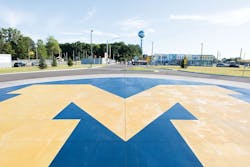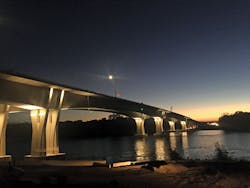Region Report: Michigan & Minnesota
MICHIGAN:
The auto zone
The state of Michigan has long been associated with the road and how we traverse it. Home to the Ford Motor Co. and General Motors, among many other automotive ventures, Michigan, in the words of Michigan Department of Transportation (MDOT) Communications Director Jeff Cranson, “puts the world on wheels.”
It is therefore no stretch of the imagination to understand that despite nationwide concerns about the readiness of our road and bridge infrastructure for full connectedness, the future of Michigan continues to lie, by and large, in the automotive segment.
“From a software development and engineering standpoint, the auto makers are investing heavily here,” Cranson told Roads & Bridges. “More patents are being filed here for automated-vehicle technology than in Silicon Valley. The resurgence of the auto industry has really made a difference in Michigan’s overall economic comeback.”
The state’s legislative willingness to cede controlling oversight on the development of driverless technology has made for what MDOT Planning Director Dave Wresinski characterized as a clarion call to those companies whose aim is to boost the advent of automation.
“Gov. [Rick] Snyder recently signed into law a bill that allows self-driving vehicles to operate on any Michigan road,” Wresinski told Roads & Bridges, in reference to House Bill 995-998, which also allows automated truck platooning and networks of self-driving vehicles to operate as transport-on-demand. “The governor has been using his pulpit to advocate for technology development and multimodal corridors. It’s a high priority for the state.”
In an effort to create an identifiable brand that ties together all of the myriad efforts taking place throughout the state, Snyder announced the creation of Planet M, a statewide mobility initiative intended to encourage research and development of autonomous vehicles and technologies for related infrastructure.
“Planet M is an umbrella initiative for everything taking place here regarding autonomous- and connected-vehicle development,” Cranson said. “This includes the American Center for Mobility, a joint initiative among MDOT, the Michigan Economic Development Corp., the University of Michigan and Business Leaders for Michigan, and the Mobility Transformation Center at the University of Michigan, which also houses the MCity testing site. Michigan Tech and Michigan State also are now jumping into the fray. It really is affecting us statewide.”
State leaders have characterized the creation of Planet M, and the legislation passed to support it, as an effort to quicken development of the technology, which promises to make roads safer and cut down on accidents.
MCity on the University of Michigan campus.
Not losing sight of the mission
All is not bright, however. MDOT has been struggling for several years with inadequate funding levels for roads and bridges, at both the state and federal levels, and system deterioration, a perennial concern, has also caused a systemic shift in the agency’s protocols and priorities.
“Michigan has long been an asset management state,” Wresinski said. “In 1999, we shifted emphasis away from new projects and increasing capacity to system preservation, for both road and bridge. We’ve made a lot of progress on state-owned bridges, but overall we have declining system functions due to many years of inadequate funding levels. So while the additional FAST Act funding is helpful, our program is largely a preservation program to slow the decline of system conditions. Increases at the state and federal level will be helpful, but they will still fall short of where we would like to be, and what we need, frankly.”
“Because Michigan is a home-rule state, local forms of government remain very strong,” Cranson added, “and this does have an effect on where the dollars go. Only 39% of road money goes to the state-owned system, another 39% goes to the counties and 22% goes to the cities and villages. The split seems fair, but it’s the overall amount that’s lacking.”
According to MDOT statistics, of the 124,390 centerline miles owned and maintained by the state, only 16.3% are considered to be in good condition; 39% are in poor condition, which has been the trend in the state since 2007; and 46% of city- or village-maintained centerline miles are rated as being poor. According to MDOT forecasting, based on anticipated funding levels the percentage of poor roads statewide is expected to reach 49% by 2019.
“Based on estimated state and federal dollars,” Wresinski said, “the sad truth is we’re now in about as good of shape as we’re going to get road- and bridge-wise for the next five years. That’s going to be a challenge for us.”
Nonetheless, MDOT refuses to lose sight of its mission in readying its infrastructure for the future.
“MDOT Director Kirk Steudle has mandated that whenever we do a rebuild of any corridor,” Cranson said, “we create the infrastructure to allow for future connected-vehicle technology, such as placing empty conduit.”
Such efforts, it is hoped, will see the state come out well ahead of the game when America is finally ready for the next-generation auto zone.
MINNESOTA:
Persistance
The Dresbach Bridge, which carries I-90 over the Mississippi River and into Wisconsin.
Out of tragedy—the 2007 collapse of the I-35W Bridge that took the lives of 13 people—came a renewed sense of purpose for the Minnesota Department of Transportation (MnDOT). The most current FHWA data indicates that just 9% of the state bridge inventory is either structurally deficient or functionally obsolete. This is the lowest in the U.S., and this statistic is doubly impressive because the states next closest (Arizona, 11%; Nevada, 13%) do not have nearly the total numbers of bridges that must be maintained in Minnesota, a state with more than 10,000 lakes and innumerable rivers, streams, ravines and creeks.
“We have developed a very robust bridge maintenance program,” MnDOT Deputy Commissioner and Chief Engineer Susan Mulvihill told Roads & Bridges. “Following the 2007 collapse, our legislature enacted a bill which provided 10 years worth of state bond funding to address fracture-critical bridges, aid redundancies and perform general maintenance.”
Yet despite the progress that has been made in the wake of this funding boon, which will expire at the end of this year, there are potentially difficult times ahead—though, according to Mulvihill, they are times for which the agency is actively in preparation. At present, more than half of the state’s roads are more than 50 years old, and 40% of its bridges are more than 40 years old. What this means is that within the next few years, a lot of roads and bridges will begin to exceed their useful service life.
“We’ve recently dug deeply into an asset management system, which we’ve wanted to do for quite some time,” Mulvihill said. “We also are in the process now of trying to get a long-term funding package through our state legislature. We have a multimodal transportation system plan, for which we went out and talked to the public to find out what they needed from us. We had approximately 12,000 public interactions all across the state. It informed our spending planning and what we propose to do in coming years. We also included the feedback of area and district engineers. It was a very inclusive process. We look at trends year to year as well, which helps us make recommendations, notably for the bridge program.”
Performance-based planning strategy for MnDOT is based on multiple factors, including ride quality, current and projected congestion levels, service life and traffic-safety considerations. This process is absolutely critical, said Mulvihill, in light of a recent determination by planners for the Minnesota State Highway Investment Plan, who indicated that during the period of 2018-2037, the state will suffer an $18 billion shortfall against what it needs to maintain state of good repair and provide a highway system that addresses congestion, meets business needs and supports a quality of life throughout the state.
In light of this and in order to maintain a dynamic service system, MnDOT is not shying away from developing multimodal systems, in advance of what future travel patterns and population-density needs will require.
“We have a Greater Minnesota transit office and we provide funding and grant opportunities for transit that is county or regionally based,” Mulvihill said. “We provide pass-through funds that provide bus service in the rural areas of the state. There is the challenge that the hours of service folks need are not always being met, weekends for example. That inconsistency is something we are working very hard to correct. And we are actively engaged with the advent of automated and connected vehicles. They are coming sooner rather than later, and one of my biggest concerns is how to enable the vehicles to communicate with the infrastructure in snow conditions. Because we’re a big snow state. How do we make sure the systems work and that they are seamless across MnDOT roads as well as county- and city-owned roads, because a driver doesn’t know who owns what road, and they don’t care; they just need a level of safety and consistency. And the automakers are ready; they’ve got the technology. But it’s only going to come as fast as we can manage it. There are standards and policy questions that need to be satisfied first. And how will this work? Cell? DSRC? A combination? How will vehicles know when they’ve gone from one state to the next what the driving laws are? But if we do it right, we really could reduce traffic-safety incidents and distracted driving.”
As for the immediate future, MnDOT is not shying away from going big with its bridges, as evidenced by the recently opened I-90 Dresbach Bridge crossing to neighboring Wisconsin. New spans across the St. Croix River (a $600 million job, also shared with Wisconsin) and a rehabilitated historic Winona Bridge will come to completion in 2017, along with several major roads projects, including a relocation of Highway 53 in the northwest of the state, which also will see the building of a 200-ft-high bridge across an old mine pit, the highest in the state.
“Transportation touches the economy every day for every person,” Mulvihill said, “so we make it a point to be persistent, to work with the public and with businesses to make sure we’re providing the transportation network they need.”
-----------------
Later installments in this series will look at the Northeast and the West Coast.


